Since 1993 Copyright Notice
Some old, but interesting multi meters
I agree, that a very good hand held meter is probably a Fluke. I have some electronic multi meters too, and they have two main disadvantages for me: 1) The have a battery, and 2) They have no needle.
Time line of battery leakage.
Batteries seem always empty when I do not expect it, and damaged a lot of my equipment stuff over the decades. In the 1960's batteries were a disaster, leaking this rust generating fluid already before they were fully empty. There would be some white powdery substance underneath the paper cover, und from there, they soon would begin to leak so much fluid that you wondered where it all came from.
In the 1970's came the 'leak proof' batteries, and also 'transistor' batteries, with a better discharge behavior, and these cost extra. In the 1980's batteries were at it's best, because the high contents of Mercury and Cadmium was no problem by then. It seemed the leakage problem was solved.
Today, quality of 1.5V batteries is back to the bad level of 1960 again, Free of Cadmium and Mercury, they can hardly be stored longer than a 3 years, and they leak just as unexpected, and already when still half full. Same is in the good old days. This part of nostalgia has come back to us :)
It seems however 1.5V Lithium Batteries are the 'solution'. I am using these now, and so far no problems.
Here you find some multi meters caught my attention for some reasons.
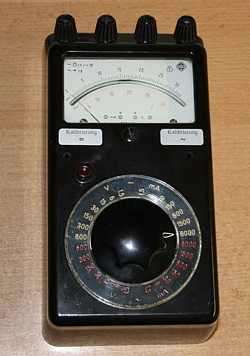 EAW East Germany.
EAW East Germany.
Very boring to look at, and I bought it only to calibrate my AVO tube testers, because it has the same impedance as the AVO-8 multi meter, and I needed one. A good AVO8 is very hard to find. WIth the EAW however I realized what this is, when I received it. It had a tout band meter with mirror scale, and that is usually a very good meter. So a tout bad is friction free, more sensitive, more precise, more linear, and more expensive, and more everything. Later, I finally found a good working AVO8, so I sold this EAW meter so somebody who indeed is working on AVO testers as well. But this meter works as nice as it is bad looking. It has a one calibration pot meter inside for AC and one for DC in general. So it was designed with precision in mind. It was easy to drill two 3mm holes a hole in the deck, and then I could can calibrate the meter from the outside. This gives the option to calibrate for instance a particular DC range, let's say the 30V range. Set it exactly right, and then use this for what I want to do with it. Since these meter looks really ugly, nobody even looks at them in Ebay. I payed only 7 Euro, but when someone puts them for auction beginning at 1 Euro, you may as well be lucky for 1 Euro. What is nice, it has separate banana connectors for voltage and current. (So the four you see at the top) and they did some intelligent switching at the inside. You can hook it up the four terminals to a circuit. Two for the voltage and two for the current. Then change from voltage to current measurement without having to plug cables, as with almost any other multi meter. After playing with this EAW, I realized that they ALL saved on this fourth banana connector. So you can buy a 500 Euro fluke, but you don't have this option.
So with the four banana terminals, it becomes hard for a fool like myself, to swap current and voltage by mistake. Also there is a security button, you need to unlock before changing to another sensitivity, which works simple and good. Also some very intelligent switching was done inside, to short the current terminals when you change the range, and forget to unlock the meter. (So when you change the range, the security button pops out, and the current terminals are shorted and the voltage terminals are opened). I am not sure if it had mechanical overload protection, but the mechanics inside suggest it.
Make sure the case is has no cracks, and the bottom is not scratched as it has printed quick the use guide on the bottom. This is just a very nice tester almost for nothing. They appear every now and then, so you can pick a nice one.
UNI10 by MTM Messtechnik Mellenbach Thueringen VFB.
Build in 1981 in the socialist paradise of the DDR Germany.
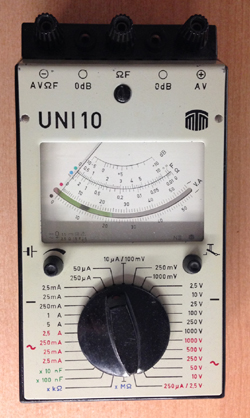 It looks also a bit ugly, but it does reflect a little bit the design style of the 1980's This is the best analog multi meter I have ever seen, because of it's incredible sensitivity and precision, and build in electronics, and several ways to use it, with two AA batteries, or with a build in power supply from the mains, or totally passive, so without any electronics. It has also some disadvantages, but in short, I would say, when you want to buy something weird, this is it. Only it doesn't look weird, just very down to earth. A disadvantage to my opinion is, the panel meter is upside down, I find it strange. But indeed it is better, because now the mirror scale is better visible. Another disadvantage is, the scales do not correspond with any of the voltages. So the 2.5V scale you need to read from a '50' scale and that is the only scale one it has. But my complaints list ends already here.
It looks also a bit ugly, but it does reflect a little bit the design style of the 1980's This is the best analog multi meter I have ever seen, because of it's incredible sensitivity and precision, and build in electronics, and several ways to use it, with two AA batteries, or with a build in power supply from the mains, or totally passive, so without any electronics. It has also some disadvantages, but in short, I would say, when you want to buy something weird, this is it. Only it doesn't look weird, just very down to earth. A disadvantage to my opinion is, the panel meter is upside down, I find it strange. But indeed it is better, because now the mirror scale is better visible. Another disadvantage is, the scales do not correspond with any of the voltages. So the 2.5V scale you need to read from a '50' scale and that is the only scale one it has. But my complaints list ends already here.
What is the BEST I HAVE EVER SEEN, is a 10uA current scale. This was only possible because MTM made their own tout band meters. Or, use it as a 100mV DC meter. Yes you read it correct. So at the 10uA setting, it has 0.1V drop. Probably the panel meter itself is even more sensitive. This 0.1V drop is theoretical, because when you measure for instance 2uA you have only 20mV drop. Or, in case you really have 10uA but can not use the 0.1V drop, set it to 50uA, and the drop is only 20mV. Mind you, this is for a fully passive meter. Any digital, new made meter which can do the same, you will have to pay a fortune, And it has a mains cable on it. Any new hand held digital meter will badly disappoint when trying to measure 2uA. (Do it!)
Repairs and maintenance needed: There is coupling capacitor at the 800Hz output, to remove the DC from the transistor output. Since that cap was never used under voltage, it was leaky, and needed to be replaced. The switch has some wheel inside with teeth, which are originally not lubricated. The sound and the feel is too harsh. I applied some silicone grease on it, and also oil some other moving parts, because it is quite a complicated mechanism. Instead of raw and primitive, the knob feels now smooth and sounds good.
Ebay. The UNI 10 looks not attractive, and we learn on Ebay quickly, that non-sexy items are low cost. And yes it looks so boring, you can find a UNI 10 anywhere from 5 to 25 Euro, depending on it's condition. You need to know the "UNI" meters were the workhorse in the technical departments of the socialist workers paradise where they were made. So sometimes a German seller has more than one for sale. The ones that are directly from dirty depots, don't buy any of those. There are many other types of UNI around, but these can not compare with UNI10. Buyers don't understand the difference. So a nice looking UNI-7 may score a 5x higher bid than a UNI 10 which looks less nice. Yet UNI-7 is worthless, and UNI-10 is a pearl. People just don't know it.
Here are few of the specs:
Impedance. Amazing! At 100 Volts it has an impedance of 50Mega Ohms. Tested by myself.
![]() DC current: 10uA full scale. Stand still with this. Many digital multi meters have fake specifications. They do show a digit for 0.1uA steps, suggesting this resolution, but it is for the birds. When you try to measure for instance 50.6uA, you will see the "6" is blinking between all kind of numbers, and you may not even be able to guess it's a "6". With the UNI-10 this could be read directly from the 50uA scale. So 50 plus 3 divisions = 50.6. Take your fabulous Fluke and try to measure 50.6uA. It will say 50.B. Where B means blinking.
DC current: 10uA full scale. Stand still with this. Many digital multi meters have fake specifications. They do show a digit for 0.1uA steps, suggesting this resolution, but it is for the birds. When you try to measure for instance 50.6uA, you will see the "6" is blinking between all kind of numbers, and you may not even be able to guess it's a "6". With the UNI-10 this could be read directly from the 50uA scale. So 50 plus 3 divisions = 50.6. Take your fabulous Fluke and try to measure 50.6uA. It will say 50.B. Where B means blinking.
The only affordable digital meter which does not blink the last digit is the Hewlett Packard 3465A. So again, for this please do not refer to manuals. They are all fake. Try it out, and come back. Stability of the last digit is specified nowhere. For trade purposes, when selling good over the counter, it is not legal for instruments to display an instable digit. Even so, they must have the NEXT digit stabile, and not show this. So when you buy 520 grams of meat from the butcher, all three digits must be stabile, but internally the software must prove to have a stable 4th digit.
Try it with a "so and so many digits" expensive meter, to measure in 5uA with it. You will probably see it fails BADLY. I have a so called 6 digit 34401A. Can it do this? No, it can not! In my collection only the Hewlett Packard 3465A can do this, and.... the UNI 10. But 3465A needs a warm up time, like all digital meters, before the internal reference becomes stabile.
Note: There is also a Siemens "Multizet" with a 10uA tout band, but it has no electronic protection relay
Capacitors: from 1000pF to 2uF. Not a big deal, but it works. For this it needs the mains cable plugged in. In case this cable is lost or broken, it's the same as on any old razor which works on 220V.
![]() Excellent Protection: Electronic or passive. The passive function is slow, and protects against the big mistakes. The active protection needs the battery inserted, and uses so little current in idle mode, there is no switch to turn the circuit off. (I checked, idle current draw from the battery is 4uA. So 40mAH per year, which is less than self discharge indeed like MTM writes. The protection is specified to work at 15x overload or at wrong polarity. I checked it, and it still works perfect. Also it features a vacuum tube (!) acting as spark gap, to protect against very high voltage, with virtually no delay. It's just a tine glass bulb, probably gas filled, and we better not ask what gas is in there. I don't want to know it. The passive relay protection works as an emergency solution, and it works with a reset button. So when you have pressed it, there is energy stored in a spring, which is used for reasonable fast operation of the relay. This works passive and good, at higher current. For overload protection of the sensitive 10uA meter you need the electronic protection. Just a Germanium transistor does the job.
Excellent Protection: Electronic or passive. The passive function is slow, and protects against the big mistakes. The active protection needs the battery inserted, and uses so little current in idle mode, there is no switch to turn the circuit off. (I checked, idle current draw from the battery is 4uA. So 40mAH per year, which is less than self discharge indeed like MTM writes. The protection is specified to work at 15x overload or at wrong polarity. I checked it, and it still works perfect. Also it features a vacuum tube (!) acting as spark gap, to protect against very high voltage, with virtually no delay. It's just a tine glass bulb, probably gas filled, and we better not ask what gas is in there. I don't want to know it. The passive relay protection works as an emergency solution, and it works with a reset button. So when you have pressed it, there is energy stored in a spring, which is used for reasonable fast operation of the relay. This works passive and good, at higher current. For overload protection of the sensitive 10uA meter you need the electronic protection. Just a Germanium transistor does the job.
With battery,the connections to a capacitor under test are then cut also.
Many of the other specifications are just average, but I use my UNI10 often for tube grid current tests. Which is nasty because you try to measure a few uA at a faulty tube, and when the tube fails during that, it can blow up the meter if there is no good protection.
Resistance measurement. It works good and precise, but there is no advantage over any 7$ Chinese DMM.
Calibration of internal oscillator. The oscillator is what they write "a normalized 600 Ohms source". I had no idea what that was, and what this is used for. I found this was normal in the days of analog signal transmission, and everything was always in dB. This is nothing but a 1.55V signal with precise 600 Ohms in series. So it drops to 50% if loaded with 600 Ohms. Calibration is needed because the mains is now 230V instead of 220V. The oscillator rejects this difference somewhat, but sure not completely. It would be a good idea to add a voltage stabilizer inside. There is enough room. Anyway I recalibrated it for 230V. I have no calibration instructions, but obviously one pot meter is for the output impedance, which must be 600 Ohms, and one is for the amplitude. So adjust the impedance, load the oscillator with exactly 600 Ohms, and voltage must drop from 1.55V to 0,775V. If that is the case, both pot meters are set right. With enough trying you'll get this done.
Actually this can indeed nicely be used to test a HiFi amplifier. 1.55V is ok, and the 600 Ohms is not significantly loaded by 47k. So on the bench you have a separate 800Hz oscillator, with it's own Banana connectors, and moreover, it's output is floating. I think this is even useful.
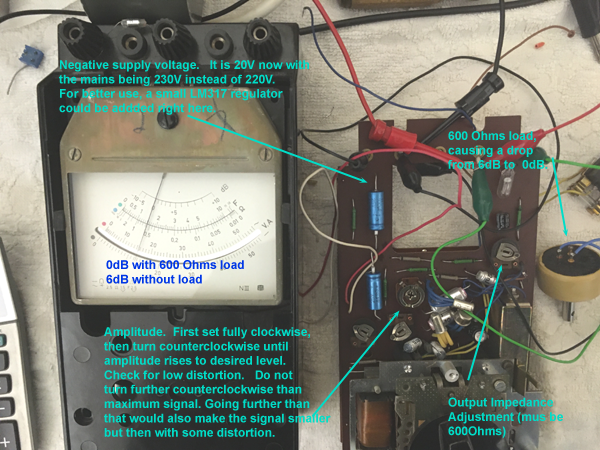
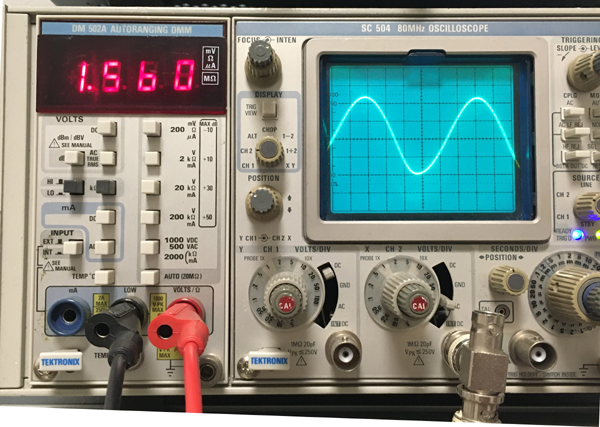
This is the unloaded signal of the 800Hz oscillator.
AVO8 by AVO. Several Millions were build over a period of 85 years, from 1923 to 2008.
No other multi meter was in production that long, and made in such massive quantity.
I think this meter is over hyped, some folks feel they MUST have one. I only use it to calibrate an AVO tube tester, because you need exactly the load of the AVO8 to do it right. Apart from that, the AVO 8 multi meter r is useful in tube land, because it has 2500 Volts range. In case you are interested, is a bit strange meter to use, and there are many AVO8 around with a deformed meter coil. This us very hard to repair, as it gives unlinearity. The different versions are from AVO8-Mk1 to AVO8-Mk7, and definitely beginning with AVO8-Mk5 they look nice. However, the Mk5 is very problematic to repair. They used a plastic foil assembly instead of normal wires, and it is difficult to take that off, as it melts easily. However, you must take it off for most repairs. Next problem is, the Mk5 has those nice looking red collars around the reset button and the "reverse" button. However, that is bad quality rubber, and it cracks. Some users peel it off then, and it looks "normal" again. The problem is, the reset button is physically part of the meter system. So when the red rubber is cracked, or peeled off to sell it on Ebay, you have now an air path directly from the front deck into the meter, and magnetic dirt will come in for sure. Also with AVO8-Mk5 and higher, the resistors inside are laser trimmed, which may have been fine by then, but the laser trimmed assembly is not painted or protected against detoriation. The burn spots are just left open. So precision of the laser trimmed parts is either already a problem now, or will become a problem later. The the highest version AVO8 I would recommend is the AVO8-Mk4. Having said that, I would never take Mk3 or lower, because they are just too old. In short: I recommend only the AV8-Mk4. And because it's probably Ebay where you buy it, let all the "experts" outbid themself for the nicest Mk7, and just buy a dull Mk4 for a low price.
Metrix MX573. Tout band meter with very precise mirror scale
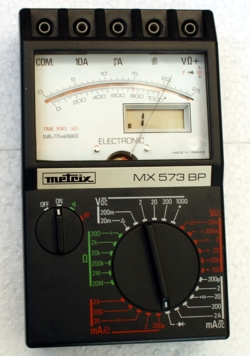
This is just a nice multimeter. Metrix still exists, as the joint company with Chauvin Arnoux. Until 2012 some MX573 stock left over was still normally for sale via the RS electronics website for 275 Euro. I don't know the production data of those, but I guess they must have been 15 years old or more. They were unused, and sold as such. In 2015 I tried calling with Metrix France to get the calibration instruction, but they were very confused by the question, not helpful, and surprised they had such a product for sale only three years ago. That was a waste of time. Later I found the calibration instructions just it in the internet somewhere.
I like using it for it's comfort. For the rest it doesn't excel with brilliant electrical specifications, but specs are not bad also. Very good is remarkable low battery usage, and a full electronic protection of every range. So theoretically you can set it for 200 Ohms, and plug it in the mains by mistake.
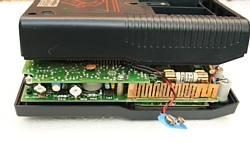 Indeed these need calibration. I have three of them, so you can see i like to work with it. They do seem to have some internal noise, meaning at high sensitivity AC, it doesn't go fully to zero, but it's just a tiny little bit, and no problem. I have the schematic and calibration instruction in French, which I can get around with. .
Indeed these need calibration. I have three of them, so you can see i like to work with it. They do seem to have some internal noise, meaning at high sensitivity AC, it doesn't go fully to zero, but it's just a tiny little bit, and no problem. I have the schematic and calibration instruction in French, which I can get around with. .
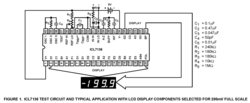 What is interesting, the digital meter is a separate unit with an analog input, just in parallel to the analog panel meter. The LCD display is a standard device, and the digital part it a single chip IC, which original chip you can still buy on Ebay as surplus. Also complete units could be tried, as the original unit is 200mV full scale, and that is still normal standard today. So try to get one digit more, with a newer version digital read out. That MAY work, and you get 5 digits. MX573 was made as an industry product, but also not a toy for the DIY market. It is in between.
What is interesting, the digital meter is a separate unit with an analog input, just in parallel to the analog panel meter. The LCD display is a standard device, and the digital part it a single chip IC, which original chip you can still buy on Ebay as surplus. Also complete units could be tried, as the original unit is 200mV full scale, and that is still normal standard today. So try to get one digit more, with a newer version digital read out. That MAY work, and you get 5 digits. MX573 was made as an industry product, but also not a toy for the DIY market. It is in between.
The Ohms measurement of the MX573 is done nicely, because it works opposite direction as with low cost analog meters. So at higher resistance the needle moves to the right. Meaning at open connections it moves all to the right, at "endless". Which is more logical as soon as you get used to it, and then you don't want anything else.
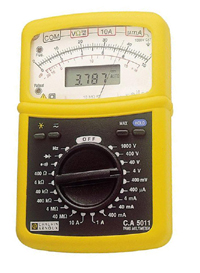 Conrad.de in Germany sells the second generation of those, under the new brand name Chauvin Arnoux now, called CA5011, for the nice price of 541 Euro. I saw some Chinese imitations for 27 Euro on Ebay too.
Conrad.de in Germany sells the second generation of those, under the new brand name Chauvin Arnoux now, called CA5011, for the nice price of 541 Euro. I saw some Chinese imitations for 27 Euro on Ebay too.
Unigor 6e. Tout band meter with very precise mirror scale
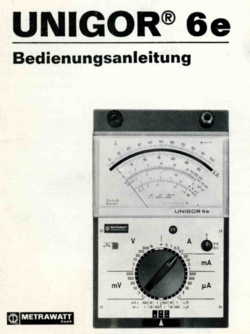
![]() This is the best ACTIVE analog multi meter ever made. Period.
This is the best ACTIVE analog multi meter ever made. Period.
It is not impossible to find, but a bit rare still. People do not really know, they just see a clunky meter, and are not interested. Also there are many other Unigors for sale which look just like the 6e, and people see too many of them. The 6e However, features a 1mV AC scale, with a beautiful 100 divisions mirror scale and a friction-free tout band meter. So you can measure AC volts in the uV range at no problem.
 Battery consumption is very low. This is best described by the way it arrived to me in 2012. It came from a military surplus store, and inside were the first Batteries still. (Yes!) They were of the type NBA3042. 4Ah 1.5V Type C, "Baby" cells. They were still full.
Battery consumption is very low. This is best described by the way it arrived to me in 2012. It came from a military surplus store, and inside were the first Batteries still. (Yes!) They were of the type NBA3042. 4Ah 1.5V Type C, "Baby" cells. They were still full.
The Unigor 6e is not just precise. It is specified for 1%, and that's what it really is. All ranges, anything.The electronic protection saved it a few times from my own mistakes, and probably also from previous users mistakes.
The unigor 6e features a FET chopper amplifier, which chops the DC signal into an AC signal, and after amplification it gets rectified, so you have a DC signal again. That way it can be amplified without internal DC offset or drift problems of the internal amplifiers. Also amplifiers can be made to block anything below the chopper frequency, so mains hum doesn't affect it either. Amazingly the internal parts are not even that much, and the PCB material is very old fashioned. Yet it's functioning is really good.
Interesting feature of electronic multi meters is normally, the scales for AC and DC are the same, as they use electronic rectification (not rectification with a diode, which looses the forward voltage). So it has a linear scale for AC too.
About old batteries...
Over the decades, leaking batteries have damaged a lot of me equipment. Batteries were a disaster in the 1960's I can tell you that. They have become substantially better in the 1980's, but is seems to me the Chinese have successfully managed to make them as terrible again as they were in the 1960's. But... some good examples exist too. Here are some examples of batteries I saved up, that refused to leak. The oldest one I have is a sharp GII battery, from 1988 and we used for 28 years, daily, in our TV remote control. This makes me think, a small current consumption, irrelevant to the capacity, may perhaps help to prevent leakage. At least this does change the chemistry inside. Current draw is only a few mA and only when you push a button. But you don't know my wife and daughter. They zap the remote control continuously. Still, the original batteries were never replaced ever since, until 2016 when we threw the whole SONY TV away, still working good, as analog TV signals were switched off. I removed the old batteries, because today we have to dispose of those separate. Much to my surprise they were the first (with date code 88-10 on the bottom of them) , and still at 100% charge. Isn't that crazy?! I kept them in my curiosity box. I recently measured them in 2022. One is still nicely at 1.45 Volt, now after 34 years.
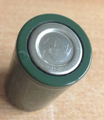
 These army batteries were in my used Unigor-6e multimeter when bought it, and they have date code 1990. But the Unigor 6e draws almost no current when it is switched on, and moreover it is switched fully off after use, with a real switch. When I bought this Unigor in 2012, the seller wrote the batteries were low. After checking them, one was 0.5V the other three had still 1.45V. So it was running on 5 V which is above minimum 4V specs. In the bottom was date code November 1990. Unbelievable! I took them out, and saved them as curiosity. Two self discharged 2020. The last of the four batteries self-discharged in 2022, so the last one stayed good for 32 years.
These army batteries were in my used Unigor-6e multimeter when bought it, and they have date code 1990. But the Unigor 6e draws almost no current when it is switched on, and moreover it is switched fully off after use, with a real switch. When I bought this Unigor in 2012, the seller wrote the batteries were low. After checking them, one was 0.5V the other three had still 1.45V. So it was running on 5 V which is above minimum 4V specs. In the bottom was date code November 1990. Unbelievable! I took them out, and saved them as curiosity. Two self discharged 2020. The last of the four batteries self-discharged in 2022, so the last one stayed good for 32 years.
Lithium Batteries
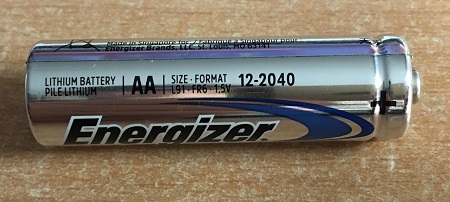 Lithium Batteries are not new by itself, but today many new variations on their chemistry have occurred, and it seems to me we have a real technology change coming up here. As well for rechargeable as for disposable batteries. The final end of the leaking battery decades. (Not talking here about artificial batteries, made from Li-ion batteries with electronics inside to simulate a 1.5V battery). I checked some youtube videos of people taking them apart, to fire down the lithium foil. Most of all, I see no wet stuff inside, just dry foil, or it looks like dry to me, and Energizer advertized them as leak proof. When searching for Lithium battery, you get always showed rechargeable batteries, or 3.6V batteries. Which are not these here. These are disposable batteries, with only 1.5V. I bough a 10-pack of those for 14 Euro (while I write this is Nov 2020). Expiry date is 12-2040. These are now in my UNI-10, to power on the meter protection circuit. This circuit can not be switched off, but the current draw of it is is 4uA. So 40mA/h per year, or 800mA in total over 20 years. They are specified at 3500mA, and moreover they hold the voltage until the very end. Mmm... when this is all true, this is a perfect product. Data Sheet here.
Lithium Batteries are not new by itself, but today many new variations on their chemistry have occurred, and it seems to me we have a real technology change coming up here. As well for rechargeable as for disposable batteries. The final end of the leaking battery decades. (Not talking here about artificial batteries, made from Li-ion batteries with electronics inside to simulate a 1.5V battery). I checked some youtube videos of people taking them apart, to fire down the lithium foil. Most of all, I see no wet stuff inside, just dry foil, or it looks like dry to me, and Energizer advertized them as leak proof. When searching for Lithium battery, you get always showed rechargeable batteries, or 3.6V batteries. Which are not these here. These are disposable batteries, with only 1.5V. I bough a 10-pack of those for 14 Euro (while I write this is Nov 2020). Expiry date is 12-2040. These are now in my UNI-10, to power on the meter protection circuit. This circuit can not be switched off, but the current draw of it is is 4uA. So 40mA/h per year, or 800mA in total over 20 years. They are specified at 3500mA, and moreover they hold the voltage until the very end. Mmm... when this is all true, this is a perfect product. Data Sheet here.
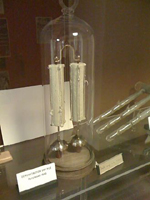 The oldest still working battery of the world, the "Oxford Electric Bell" battery from 1840. Also used with small current spikes, but regularly. This is not a joke. Search on youtube for 'Oxford Electric Bell'.
The oldest still working battery of the world, the "Oxford Electric Bell" battery from 1840. Also used with small current spikes, but regularly. This is not a joke. Search on youtube for 'Oxford Electric Bell'.
Today my Hewlett Packard 6236 Power supply went up in smoke.
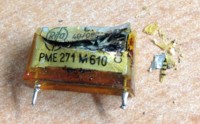
![]() Read why using 220V devices on 230V can catch fire.
Read why using 220V devices on 230V can catch fire.
Philips GM6004
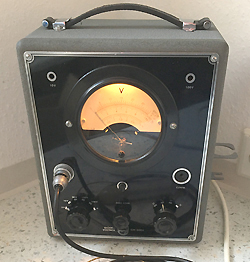
![]() I have good memories to this one. When I was young, my father brought me this meter as a gift in 1979. Today there is little use for such a tester, I suppose it makes only sense for radio frequency, because it is really good at that. If you ever repaired the HF part of a radio, you will know, a self made diode-test-head from a Germanium diode will somehow do the job, but not if you need reliable numbers. After revising it, I had great respect for the way it was build. Read more.
I have good memories to this one. When I was young, my father brought me this meter as a gift in 1979. Today there is little use for such a tester, I suppose it makes only sense for radio frequency, because it is really good at that. If you ever repaired the HF part of a radio, you will know, a self made diode-test-head from a Germanium diode will somehow do the job, but not if you need reliable numbers. After revising it, I had great respect for the way it was build. Read more.